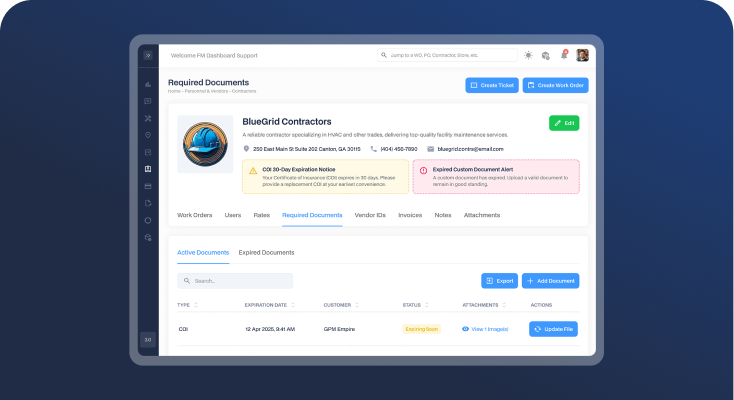The 3 habits of stress-free facilities managers.
Your job is stressful. You start every work day with an inbox full of problems. Your phone rings off the hook with stressed out store managers, people looking for answers, bosses demanding explanations, vendors asking for more money, and work orders piling up. And that's before your first cup of coffee.
You spend your day putting out one fire after another. You end your day exhausted and asking yourself, "What did I even accomplish?" After hours, your phone keeps ringing. You go to bed but can't sleep. Your mind is still making sense of everything you are responsible for and wrestling with unsolved problems.
The stress is bleeding into your personal life. There is no such thing as work-life balance. You are just trying to survive and hold it all together, are burned out, fed up, and out of ideas and wonder if you should just find a new job.
It wasn't always like this. You were full of energy, hope, and ideas when you first took this job. You imagined a day full of progress, checking boxes on your to-do list, negotiating with vendors, making deals happen, writing processes, and mostly helping people solve their problems. People around you would wonder, "How do they do it all? What's their secret? That job must be easy!"
What if it could be this way? What if the only thing you are missing is a framework which, if applied and consistently worked overtime, could make you more effective, your job less stressful, and actually allow you to enjoy your life outside of work?
The truth is, there is a villain robbing you of the job you deserve. This villain in loud. It demands your attention, seeks to destroy your productivity and deceives you by making you feel like you are spending your time wisely. But secretly, it only exists to hold you back. The villain is reactive work.
This plan is for you if you are at a point where you are fed up and ready to try anything that will help you reduce the stress you feel. It's a simple three-part framework, and this post will teach you how to apply it to facilities management.
The alternative is you stay where you are, stressed out and burned out. Or maybe you have to go through the grueling process of finding a new job. Either way, what got you here will not get you to where you want to be.
The three-part framework of a stress-free job.
The reason people feel stressed out and overworked is not because they have too much work to do. It's because they don't know the right things to do. Even those who are fortunate enough to work for an organization that provides clear goals and objectives, they still lack a process for getting that work done.
They show up to work with a list of tasks and growing list of seemingly urgent requests of their time. Yet, they are not given a system to prioritize what needs to get done. The message they receive is, "Take care of all of this, and don't drop the ball."
Not all work is the same. Not all work is created equal, and not all work needs to be done by you. This is the backbone of the time management system you are about to learn. Batch, stack, and automate.
Batch
Not all work is the same, so you must batch similar work together. There is a cognitive burden when you are constantly switching from one task to another. In his book, Deep Work, Cal Newport writes about a study by Sophie Leroy, a business professor at the University of Minnesota. She coined the phrase "attention residue" referring to the part of ones attention which remains with a previous task when switching to the next task.
"The problems this research identifies with [task switching]," Newton writes, "is that when you with from some Task A to another Task B, your attention doesn't immediately follow—a residue of your attention remains stuck thinking about the original task."
The way around this is a formula that is foundational to Newton's book: High-Quality Work Produced = (Time Spent) x (Intensity of Focus)
Simply put, to be more effective, you must batch similar work together and focus solely on that work.
Stack
Not all work is created equal, so you must stack your work in order of most to least important. This is especially critical if your job is reactive. But, how do you determine what is most important? In The 4 Disciplines of Execution, the authors recommend a better question.
Instead of asking yourself, "What's most important?"
You should ask, "If every other area of our operation remained at its current level of performance, what is the one area where change would have the greatest impact?"
They argue, "This question changes the way you think and lets you clearly identify the focus that would make all the difference."
Your job gets easier and you become more effective when you accomplish tasks that have the greatest impact on improving your department and function.
Automate
Not all work needs to be done by you, so you must automate anything that can be done by processes, software, or other delegating work to people. The E-Myth Revisited opens by telling a story of a skilled technician who masters a skill at such a high level they start a business. The business grows because the quality of work is excellent. Because of the growth, the technician hires people. Soon the quality suffers, and the business atrophies.
People have a hard time moving from skilled technician to leader, but the transition is simple. It requires the technician first to document how they do what they do, and then to train other people how to do it. This requires written processes.
Once a written process exists, the leader can decide how to automate the process, either through software or by delegating work to others. And yes, even if you are a department of one, you can still delegate work to others.
Appling batch, stack, and automate to facilities management.
Whether you are a department of one or many, your facilities maintenance operation is larger than you think. You have a network of store managers, an operations department, a finance department, and network of vendors and technicians serving your stores.
You lead this operation, and to be more effective and less stressed in your job, you must organize your entire network towards the same goal. In facilities maintenance, the goal is to keep the condition of each location consistent with your company's brand image.
To achieve this, what's working needs to be maintained, what's broken needs to be fixed, what's missing needs to be obtained, and what's confusing needs to be clarified. These needs are written in order of priority.
The following section lists out how to stack your day with batched activities to be the most effective and reduce the amount of reactive work you perform. Focus on each batched activity. Do not allow any interruption except emergency work orders or if a vendor is onsite and needs additional cost approval.
If you follow this process and train your team to do the same, you will find your react less, stress less, like your job more, and get to enjoy your life at home.
How to start your day.
Every day starts the day before. Spend the last fifteen minutes of each day taking account of the highlights of the day. What went well? What did not go well? What do you need that you don't have? Is there anything you need to clarify or training you need to provide to a team member? Write these down in a notes app or a notebook. Then leave it for the next day. This is called your "Make it Better List."
The First 30 Minutes of Your Morning.
Don't check email or voicemail. Get out your note from yesterday and choose one item that needs your attention. Remember the question, "If everything else stays the same, what is the one thing you can improve that will make the greatest impact?" Write that down at the top of your to-do list. It will be the first thing you work on. Next write down three ideas you have for tackling that one item. This will give you inspiration when you move on to this task.
Check for emergencies.
Open your email or work order management software and quickly scan for new emergency work orders. Emergency work orders affect sales, safety, or security (and sometimes an executive visit). If it does not fall into one of these categories, do not touch it.
Update work orders.
Getting information is the most time-consuming part of a facilities manager's day. When you don't know what is going on with your jobs, you can't answer questions from your peers and you are more likely to be "surprised" with bad news later in your day. The solution is to spend the first part of your day following up on every open work order you are responsible for managing.
This sounds like a daunting task, and it will be at first. But you need to think of this practice like diet and exercise. It takes time up front, but it could prevent you from having a heart attack.
If you practice this consistently and properly, it is an opportunity to train your technicians and vendors on your expectations and will keep you from an issue that derails your day and productivity later on. It looks like this.
-
Turn on Do Not Disturb. Shut down your email. Ignore inbound requests (except emergency work orders).
-
Find your oldest open work order. Note who the contractor or technician is, and find every open work order associated with them.
-
Pick up the phone and call them.
-
Explain that you are calling to get updates on every open work order they have and that you will be doing this every day. Let them know if they provide you with proactive communication daily, you will not have to call them to ask for updates.
-
Update each work order with a note. You need updated the status, the next step, and the ETA for the next step.
-
If you don't receive the answer you need, create a task to call back later for the answer.
-
Repeat this until all of your work orders are updated.
Again, this will be the most time-consuming part of your day, but over time, you will find your vendors and technicians will have already provided you with the information you need (automation through delegation).
Dispatch work orders.
You probably received new work orders while you were updating existing work orders. Dispatch them to your vendors and technicians accordingly.
Missed ETA's.
Find all the work orders where a contractor or technician did not show up on time. Call them and get an update. This is also the time to train them on expectations. Explain why it's important they proactively update you if an ETA will not me met. Let them know you don't like making the call as much as they probably don't like receiving it.
Unaccepted work orders.
Find every work order where a contractor or technician has not accepted it or confirmed an ETA. Call them to get an update. Explain why it's important they accept work orders and confirm ETA's in a timely manner. Let them know you don't like making the call as much as they probably don't like receiving it.
Approve quotes and invoices.
Find every quote and invoice which needs to be approved. Approve them or reject them. If you must reject the quote or invoice, be sure to explain why it is being rejected. This is another opportunity to train others on expectations. The more you train others, the less time you will spend correcting problems.
Check your email, voicemail, and follow ups.
The best part about stacking your day for success is most of your emails and voicemails will be for tasks you have already handled. You will process these quickly because there will be nothing to do. If there is something that can be done in under five minutes, do it now. Otherwise, save it for when you can batch with similar tasks. This is also the time to call back about work orders which still need an update.
Work on your one thing.
Now is the time to get out your note from this morning where you wrote down the most impactful tasks and three ideas to solve the problem. Block out 30-45 minutes and get to work solving it. Maybe it's a new process or a new training. Maybe you need to find a new contractor for a specific trade or store. Whatever it is, now is the time to get this work done.
Manage work orders.
Go back through open work orders:
-
Follow up on information.
-
Dispatch work orders.
-
Update missed NTE's.
-
Confirm unaccepted work orders.
-
Approve quotes and invoices.
Make things better.
If you have time left in your day, use it to work on the next most impactful item on your Make it Better List. Often this work will focus on tasks you can automate. You might spend it training others, finding software that better suits your needs, analyzing data to make better decisions, or creating preventative maintenance programs.
You will notice over time, you have more time for this type of work. You will be full of energy, hope, and ideas. Your day will be full of progress, checking boxes on your to-do list, negotiating with vendors, making deals happen, writing processes, and mostly helping people solve their problems. People around you will wonder how you do it all and assume your job must be easy.
What will you do?
Perhaps this exact plan won't work for your unique situation. You have a baker's dozen good reasons why it's not worth attempting. But if what you are doing is not working, what are you going to do?
Too many facilities managers have unnecessarily difficult jobs. They've accepted a lie that stress and burnout is part of their job. This could not be further for the truth.
You deserve to have less stress. You deserve to have a fulfilling job, work-life balance, and to fall asleep easily at night.
But this won't happen on its own. It will only happen when you choose to change the way you approach your day.
 By
By



